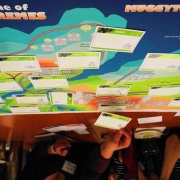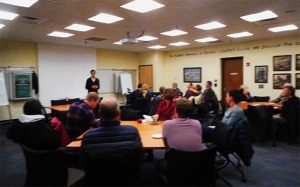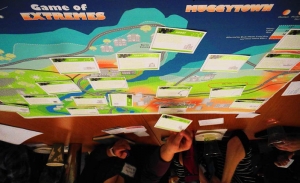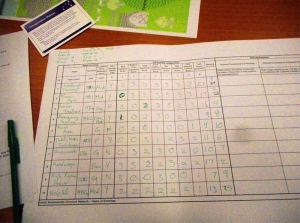Game of Extremes
On November 21, the City and County of Boulder and the Urban Sustainability Director’s Network (USDN) hosted an opportunity to simulate Community Environmental action through a the Game of Extremes. The thirty plus participants were drawn from staff, participants in the Better Together Resilience trainings, and CMAP Resilience working group members. It was a snowy evening and the turnout was about three quarters which actually was phenomenal.
The Game of Extremes can be thought of as a melding of Settlers of Catan and Sim City, with some C-Roads thrown in. It is a board game with each table having 10 persons, each with a persona to act as: mayor, emergency services, transportation manager, public engagement manager, waste water treatment manager, public health commissioner, and others. Each table is given a scenario that combines water rise, flooding, and heat as increasingly damaging conditions. Then you are given a playing board, and a stack of assets which the community must choose the 10 most important from through collaborative elimination.
Then the 10 selected assets are ranked by importance by scoring their severity. The community is then given a variable amount of Federal money and asked to budget their work on the selected assets. The work ranged from adaptation to remediation (treating symptoms and root causes). The communities were not given enough funding so hard choices were having to be made. For instance one table had rebuilt their flood prone commercial district but had no money for emergency services or hospital. At our table, the mayor actually replaced a selected working asset with the discarded asset which protected the high end gated community he lived in. The Feds came through and fined communities for not acting soon enough, then came through and offered more funding. At this point we were scrambling to get our plans done, so we resorted to parallel distributed budgeting with a central tally. At this point the game was mirroring real life in a disturbing way.
The final plan took the form of a spreadsheet, each row a selected working asset. Each asset had risk assigned to it, a plan to benefit each working asset, and a cost to do so given the budgetary constraints.
Each table did a credible job of presenting its adopted plan by its mayors. One table did a magnificent job of presenting its findings, until a member of the group pointed out they had no emergency services or hospital.
All in all, the game is worthy of participation if not to give each of you the appreciation for the hard work done at the emergency planning level. The game is cleverly designed to leave out certain important stakeholders, which is designed in to spark post game conversation about who is missing. It is a game, and there must be some suspension of judgement in order to play it. It was often disturbing just how well some of the roles were acted out. Our mayor was downright corrupt and the supremists in the high end estates really tried to exercise every privilege in the book. There are other associated games that move along similar lines.
I find these simulations are so much better than death by powerpoint download. They really get to the heart of our dilemma, which is that community building lies at the heart of Climate mitigation efforts.
Hope you get a chance to participate in the next round!










